Skelton - North Riding
Green Road
Marlborough Road
Marlborough Road
There have been three drill halls in Skelton:
Kelly also refers to a Drill Hall, 93 High street
Units recorded in Skelton:
The 1901 Census records Colour Sgt Drill instructor Arthur Booth 1901 living at 95 High street.
We know from sources such as Bulmer (op cit) that the former chapel was used as a drill hall from 1877 and was still in use as such in 1890. By 1909, Kelly refers to Wharton Hall as the Drill Hall.
Military activities are sometimes mentioned in the Parish Magazines.
In April, 1892, the Parish Magazine anticipated the arrival of a large military camp in the vicinity. ‘It will make rather a stir in the village when we have the Leeds Rifles, under General Wilkinson in camp in the Fishpond field. They are expected to march in on July 30th to the number of 3,000 foot and horse. Already tenders are invited to supply beef, bread, tea, coffee etc.’
The camp duly arrived. In August, 1892, the Parish Magazine reported on a particular treat: ‘The visit of the Leeds Rifles cheered our drooping spirits very much, which had been down at zero for the past four months in consequence of the long stoppage of work in the district. The drumhead service in the field, with His Grace the Archbishop of York as preacher, the spiritual and instructive sermon at the Parish Church in the evening by the Chief Pastor of the Northern Province, the music of the three massive bands, the attractive uniforms of the men, the picturesque and instructive movements in the field of drill, the sham fight on the moors, the inspection of the battalions, the sports and torchlight procession are scenes and events which we shall long remember with profit and pleasure.’ The Volunteers’ Church Parades took place annually and seem to have been popular occasions, with the marches watched by many spectators. On Whit Sunday, 1891, ‘The Skelton Volunteer Corps had their Church Parade. Assembling at the Drill Hall, they marched under the command of Captain Hamilton to the Parish Church, their band headed by Sergt-Instr Freen leading the way.’
Or, in June, 1894, ‘The Volunteers had their Annual Church Parade. The day being fine, a good many spectators were grouped on the Hills and in High St to witness the march up the village.’
On Whit Sunday, 1905, ‘About 70 members of the G Company [Skelton] 1st Volunteer Battalion, Yorkshire Regiment paraded at the Drill Hall and headed by their Band marched to Church to attend Divine Service.’
The Volunteers’ annual camp was often noted. For example, on 11th June, 1892, the magazine reports: ‘Our Volunteers will go into Camp at Whitby for a week's training with the rest of their Battalion’ and in 1894, ‘We understand the place chosen for their annual week of training under canvas is Redcar and that they will march off from Skelton on Saturday, June 9th. Sergeant Treen, who has been drill instructor to the Corps for the last fifteen years has retired on a pension and his place is taken by Sergeant Wright, who has lately been employed as recruiting officer at Thornaby.’
We are very grateful to Bill Danby for permission to reproduce these items and pictures from his website 'Skelton-In-Cleveland' and for his insights into the drill halls at Skelton.
The Drill Hall at Marlborough road was in use during the Second World War and it may possibly have dated back to 1913 (unconfirmed). It continued in use as a drill hall and eventually became the British Legion Club. It was badly damaged by fire and the site is now a block of flats shown as Marlborough Court on modern maps.
The old Wesleyan chapel is now a house.
Wharton Hall has been converted into housing.
- Former Wesleyan Chapel, Green road from 1877
- Wharton Hall, Green road (dates unconfirmed)
- Drill Hall, Marlborough road (?) from 1913
Kelly also refers to a Drill Hall, 93 High street
Units recorded in Skelton:
- 'G' 4 Prince of Wales’ Own Yorkshire Regiment
- Skelton-in-Cleveland: 1st Volunteer Battalion Alexandra Princess of Wales’s Own (Yorkshire Regiment) G Company – High Street (Kelly, 1905)
- Skelton: 4th Battalion Alexandra, Princess of Wales’s Own (Yorkshire Regiment) (G Co); head quarters, 93 High street (Kelly 1913 – certainly post-’08)
The 1901 Census records Colour Sgt Drill instructor Arthur Booth 1901 living at 95 High street.
The three drill halls:
Former Wesleyan chapel
Bulmer’s ‘History and Directory of North Yorkshire’, 1890, states that the drill hall in Skelton was a former Wesleyan chapel dating from 1813 which became redundant after a new chapel was built in 1877.We know from sources such as Bulmer (op cit) that the former chapel was used as a drill hall from 1877 and was still in use as such in 1890. By 1909, Kelly refers to Wharton Hall as the Drill Hall.
Wharton Hall
Kelly 1909, records Wharton Hall as the location of Territorial Force Battalion 4th (Alexandra, Princess of Wales Own) Yorkshire Regt. Wharton Hall, on Green road, was built by the Whartons of Skelton Castle and had many community uses as well as its role as a drill hall. (It was used as a Home Auxiliary Hospital during the Great War.)Marlborough road
In 1913 a new drill hall was built at Skelton on Marlborough road. According to an unattributed reference (no citation) on the ‘communigate’ website, the new drill hall was built in 1912, but as there is some confusion in the author’s text, we make no comment on the accuracy of the date. The drill halls. the military and the community
References on the Skelton in Cleveland local history website show that the drill hall was well used by the community, for example, for talks, Sunday school classes and events, gatherings, concerts and so on. Military activities are sometimes mentioned in the Parish Magazines.
In April, 1892, the Parish Magazine anticipated the arrival of a large military camp in the vicinity. ‘It will make rather a stir in the village when we have the Leeds Rifles, under General Wilkinson in camp in the Fishpond field. They are expected to march in on July 30th to the number of 3,000 foot and horse. Already tenders are invited to supply beef, bread, tea, coffee etc.’
The camp duly arrived. In August, 1892, the Parish Magazine reported on a particular treat: ‘The visit of the Leeds Rifles cheered our drooping spirits very much, which had been down at zero for the past four months in consequence of the long stoppage of work in the district. The drumhead service in the field, with His Grace the Archbishop of York as preacher, the spiritual and instructive sermon at the Parish Church in the evening by the Chief Pastor of the Northern Province, the music of the three massive bands, the attractive uniforms of the men, the picturesque and instructive movements in the field of drill, the sham fight on the moors, the inspection of the battalions, the sports and torchlight procession are scenes and events which we shall long remember with profit and pleasure.’ The Volunteers’ Church Parades took place annually and seem to have been popular occasions, with the marches watched by many spectators. On Whit Sunday, 1891, ‘The Skelton Volunteer Corps had their Church Parade. Assembling at the Drill Hall, they marched under the command of Captain Hamilton to the Parish Church, their band headed by Sergt-Instr Freen leading the way.’
Or, in June, 1894, ‘The Volunteers had their Annual Church Parade. The day being fine, a good many spectators were grouped on the Hills and in High St to witness the march up the village.’
On Whit Sunday, 1905, ‘About 70 members of the G Company [Skelton] 1st Volunteer Battalion, Yorkshire Regiment paraded at the Drill Hall and headed by their Band marched to Church to attend Divine Service.’
The Volunteers’ annual camp was often noted. For example, on 11th June, 1892, the magazine reports: ‘Our Volunteers will go into Camp at Whitby for a week's training with the rest of their Battalion’ and in 1894, ‘We understand the place chosen for their annual week of training under canvas is Redcar and that they will march off from Skelton on Saturday, June 9th. Sergeant Treen, who has been drill instructor to the Corps for the last fifteen years has retired on a pension and his place is taken by Sergeant Wright, who has lately been employed as recruiting officer at Thornaby.’
We are very grateful to Bill Danby for permission to reproduce these items and pictures from his website 'Skelton-In-Cleveland' and for his insights into the drill halls at Skelton.
Current status
The Drill Hall at Marlborough road was in use during the Second World War and it may possibly have dated back to 1913 (unconfirmed). It continued in use as a drill hall and eventually became the British Legion Club. It was badly damaged by fire and the site is now a block of flats shown as Marlborough Court on modern maps.
The old Wesleyan chapel is now a house.
Wharton Hall has been converted into housing.
Thank you to Bill Danby for the photographs and information.
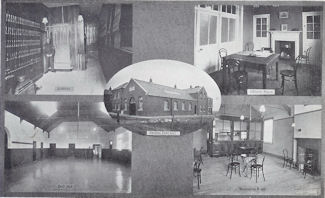
Postcard of Skelton Drill Hall. Enlarge
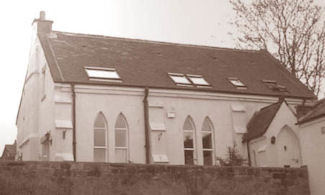
Old Wesleyan Chapel on Green road – Drill Hall
from 1877 onwards. Now a house.
from 1877 onwards. Now a house.
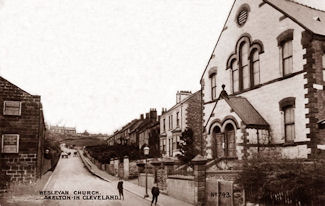
Wharton Hall, Green road – The hall is on the immediate left of
the picture. The old drill hall is just up the road behind Wharton
Hall. (The chapel shown here is the new chapel.)
the picture. The old drill hall is just up the road behind Wharton
Hall. (The chapel shown here is the new chapel.)
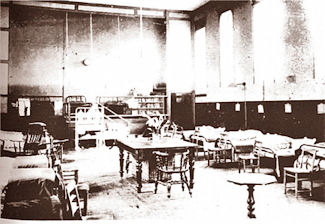
The interior of Wharton Hall, in use as a hospital.
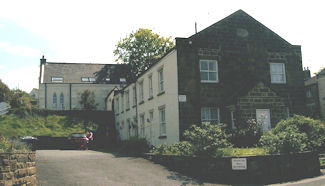
The old chapel and Wharton hall, 2008
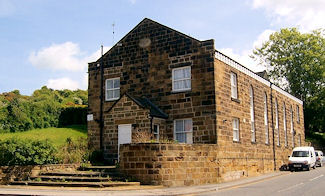
Wharton Hall, 2008
© All material is copyright - refer to the
Terms of Use
the first attempt at content
Introduction
About
Anatomy
Drill
 Database
Database
 Memorabilia
Memorabilia
Resources Glossary
Saving Halls Participate Contact What's New? Terms of Use
Drill
 Database
Database Memorabilia
MemorabiliaResources Glossary
Saving Halls Participate Contact What's New? Terms of Use
The Drill Hall Project - Charting a neglected legacy